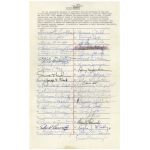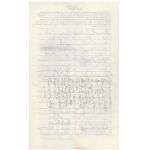Cloture Motion for the Civil Rights Act of 1964
6/10/1964
Add to Favorites:
Add all page(s) of this document to activity:

Add only page 1 to activity:
Add only page 2 to activity:
On Monday morning, June 8, 1964, Senate Majority Leader Mike Mansfield presented before the president of the Senate a cloture motion. In doing so, he and the other signatories were asking the Senate of the United States to cease debate on House Resolution 7152 – better known as the Civil Rights Act of 1964. On March 30, eighteen Southern senators, seeking to prevent its passage, had begun a collective filibuster. A filibuster allows a senator to speak on any topic he or she chooses – usually, but not always, related to the legislation in question – for as long as he or she wishes. As a result, the measure had occupied the Senate for 55 working days, including six Saturdays.
The cloture rule enabled the Senate to force a filibuster to end. After the cloture motion passed, due to the 100-hour rule allowance, debate continued until June 19. When the compromise bill was finally put to a vote, it passed 73 to 27. It was noted in the Congressional Record that applause broke out in the Senate galleries, and President Lyndon B. Johnson signed it into law on July 2.
Text adapted from “Cloture Motion to Cease Debate on 1964 Civil Rights Bill” in the November/December 2010 National Council for the Social Studies (NCSS) publication Social Education.
The cloture rule enabled the Senate to force a filibuster to end. After the cloture motion passed, due to the 100-hour rule allowance, debate continued until June 19. When the compromise bill was finally put to a vote, it passed 73 to 27. It was noted in the Congressional Record that applause broke out in the Senate galleries, and President Lyndon B. Johnson signed it into law on July 2.
Text adapted from “Cloture Motion to Cease Debate on 1964 Civil Rights Bill” in the November/December 2010 National Council for the Social Studies (NCSS) publication Social Education.
This primary source comes from the Records of the U.S. Senate.
National Archives Identifier: 5635105
Full Citation: Cloture Motion for the Civil Rights Act of 1964; 6/10/1964; (SEN 88A-M5); Various Papers, 1789 - 1982; Records of the U.S. Senate, Record Group 46; National Archives Building, Washington, DC. [Online Version, https://docsteach.org/documents/document/cloture-motion-civil-rights-act, April 23, 2024]Rights: Public Domain, Free of Known Copyright Restrictions. Learn more on our privacy and legal page.





